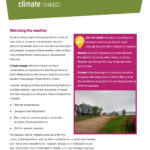All Canadians, not just farmers, are aware of the risks of extreme weather events. How many Canadians have taken steps to prepare for a possible event?

 Focus on the concept of climate change, using examples of changes in temperature, precipitation and weather patterns and their effect on farming practices in CLIMATE CHANGES.
Focus on the concept of climate change, using examples of changes in temperature, precipitation and weather patterns and their effect on farming practices in CLIMATE CHANGES.
In EXPLORING CLIMATE EVIDENCE, use sources, including graphs and maps, to assess evidence of climate change. Conduct an experiment to investigate the effect of temperature and water supply on plant growth.
climate change connections
Farming and the production of food is highly dependent on weather and climate.
Without adequate rainfall and appropriate temperatures, crops fail and pastures become barren.
Interestingly, the opposite is also true: weather and climate are influenced by agricultural practices. By managing croplands and pastures, farmers influence a series of physical, chemical and biological interactions between the Earth’s surface and the atmosphere that can affect air temperature and precipitation in many ways.
influences on crops and livestock
Temperature changes don’t just affect crops. The Climate Atlas of Canada identifies examples of events that affect both crop and livestock farms.
- The planting, maturing, and harvesting of crops all depend on consistent weather patterns in the growing season.
- Livestock depend on feed, water and environments – whether on pastures or in barns – with comfortable heat and humidity for healthy growth.
- Climate helps determine which pests and diseases will spread. Changes in weather patterns can influence the time and work needed to control these pests and diseases.
- Beyond the harvest, patterns of temperature and weather affect the way that farm products are stored and transported.
![]() How does climate affect the whole process of bringing food from the field to your table?
How does climate affect the whole process of bringing food from the field to your table?
Adapted from Climate Atlas of Canada: Agriculture and Climate Change.
An egg-sample
As the climate changes, farmers look more closely at the risks to their crops and livestock. Consider these factors that Alberta egg farmers have identified as being of most concern from climate change.
Heat stress on the birds can result from longer periods of hot temperatures.
Cost of cooling living spaces for the birds can increase from hotter summers.
Crops used to grow feed for the birds can be damaged from extreme drought. There may also be water shortages.
Air quality can be reduced from wildfire smoke – this can have a negative effect on the birds when they are transported.





